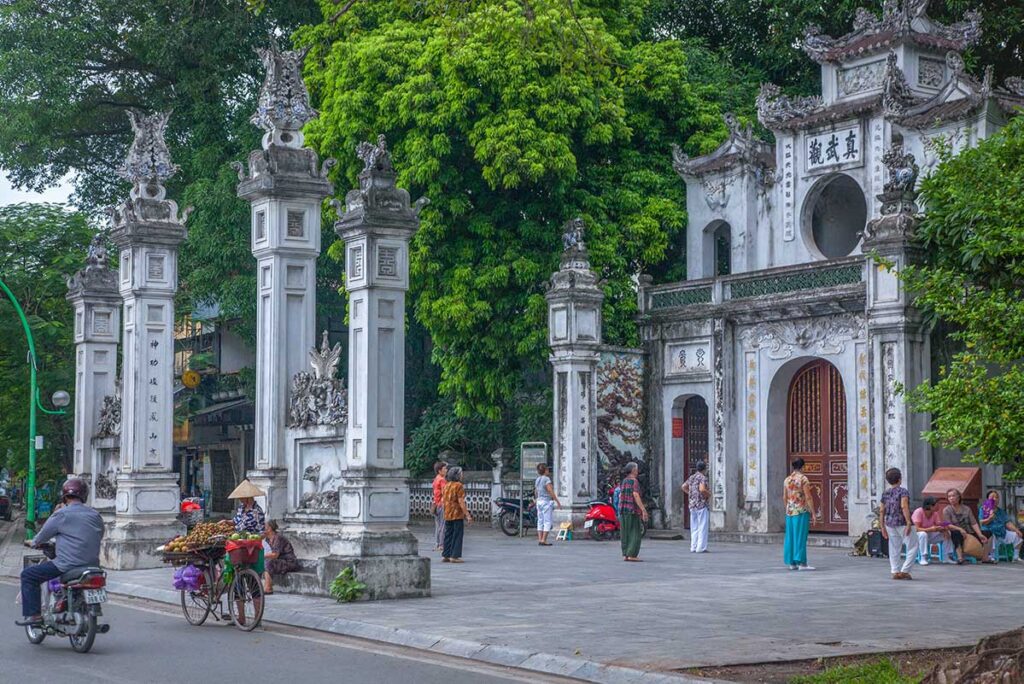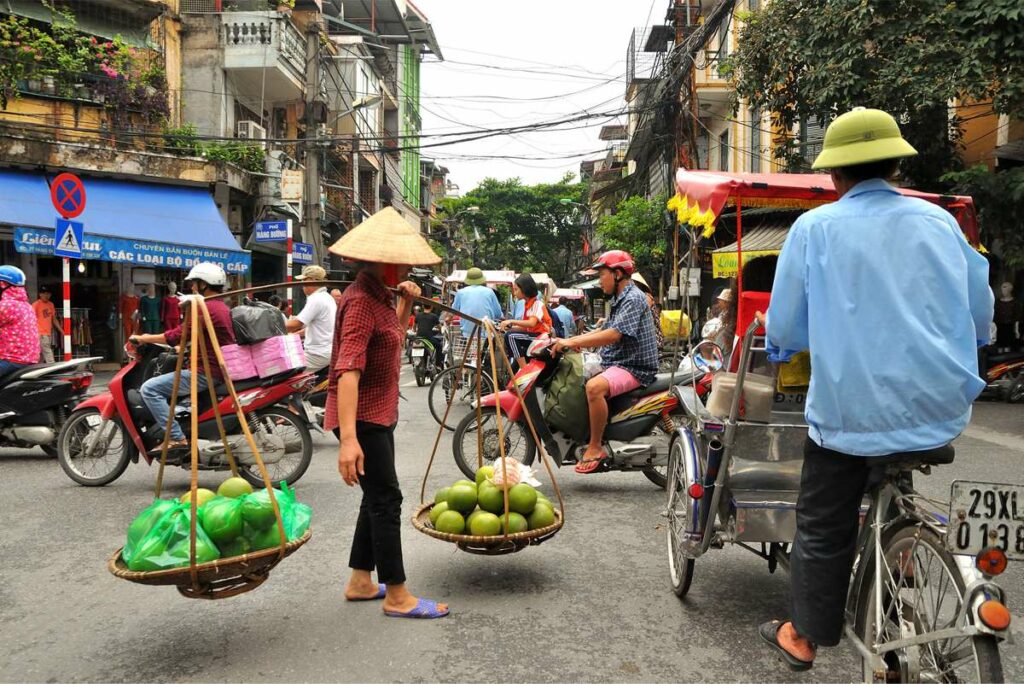What is Quan Thanh Temple like?
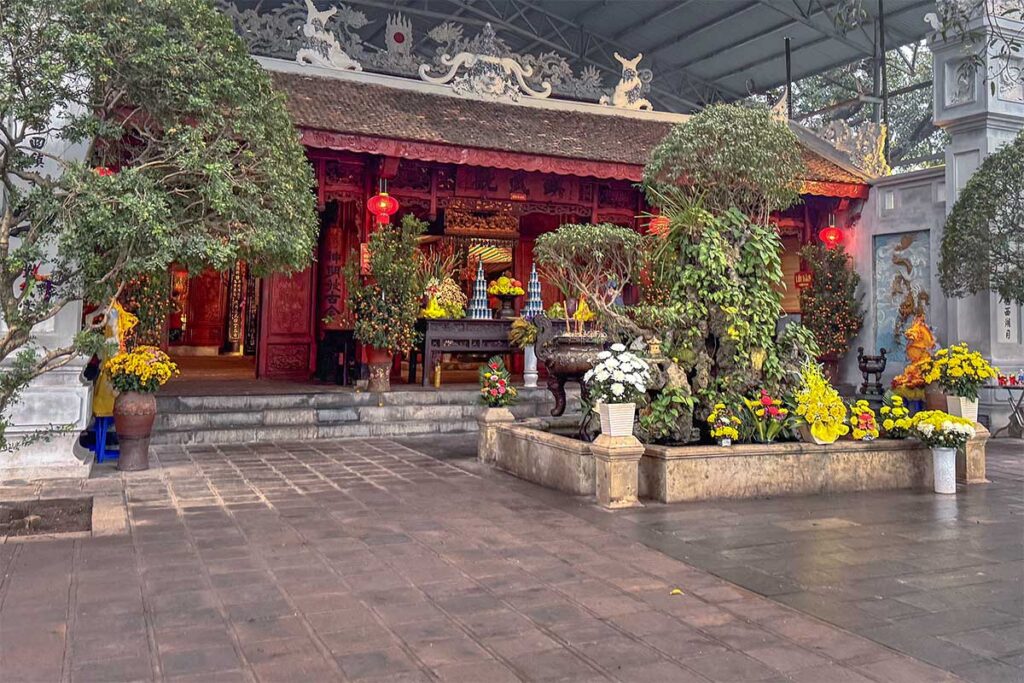
Quan Thanh Temple is a small, peaceful Taoist temple that offers a quiet break from the busier parts of Hanoi. It’s one of the city’s oldest religious sites, originally built in the 11th century and still active today, with locals stopping by to light incense and make offerings. Despite its modest size, the temple feels atmospheric — filled with the scent of burning incense, shaded by a large banyan tree, and centered around a dark bronze statue that dominates the main hall.
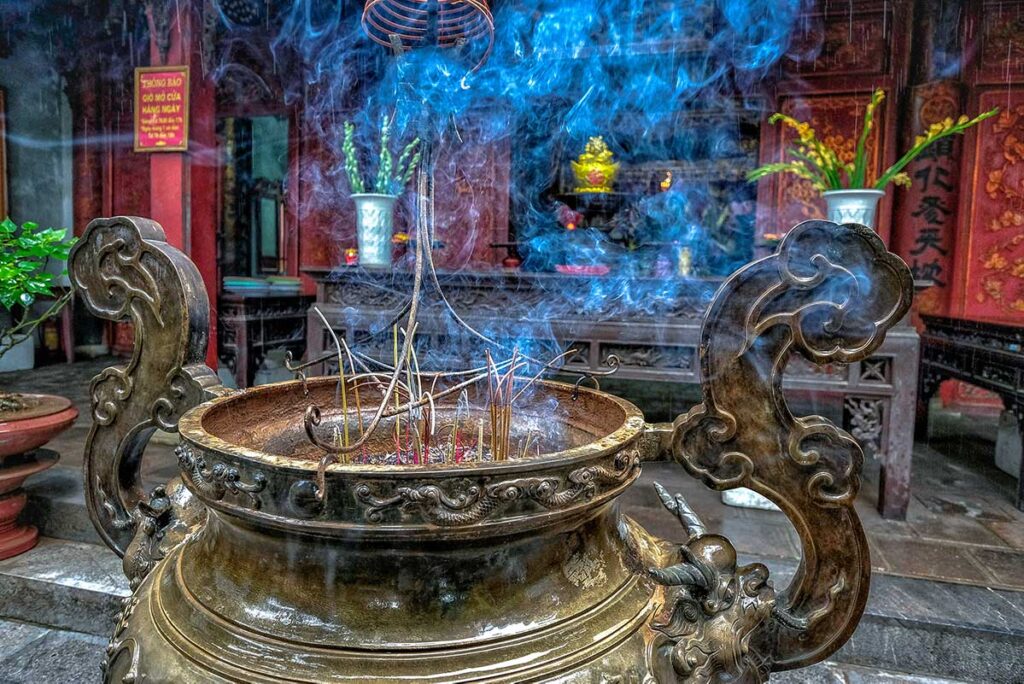
The architecture blends Taoist symbolism with traditional Vietnamese design, including wooden beams, tiled roofs, and carved stone steles. The temple sits right next to West Lake, with views of the water just beyond its courtyard. You can easily combine it with nearby attractions — more on that later.
Practical visiting information
Opening Hours
- Daily: 8:00 AM – 5:00 PM
Entrance Fee
- Adults: 10,000 VND
- Students / Children: 5,000 VND
Tip: Bring cash — preferably small bills, as card payments are not accepted.
Address
- 190 Quan Thanh Street, Ba Dinh District, Hanoi
The temple is located at the corner of Quan Thanh and Thanh Niên Street, facing West Lake. It’s just across from Tran Quoc Pagoda and a short walk from Truc Bach Lake.
→ For access options, see How to get there.
Time Needed
- Quick visit: 20–30 minutes
- Full visit: Up to 1 hour if you want to explore the architecture, read the historical steles, or observe worship rituals
Dress Code
- Wear modest clothing that covers your shoulders and knees
- Avoid loud behavior, revealing clothes, or flashy accessories
- Photography is allowed, but flash is discouraged out of respect for the space and worshippers
History of Quan Thanh Temple
Quan Thanh Temple was founded in the early 11th century during the reign of Emperor Ly Thai To, who moved Vietnam’s capital to Thang Long — present-day Hanoi. It was built to honor Trấn Vũ (also known as Huyền Thiên Trấn Vũ), the Taoist God of the North, who symbolizes protection and purification. As the northern guardian, the temple became one of the Four Sacred Temples (Thăng Long Tứ Trấn) positioned at each cardinal point to shield the ancient capital from evil spirits.
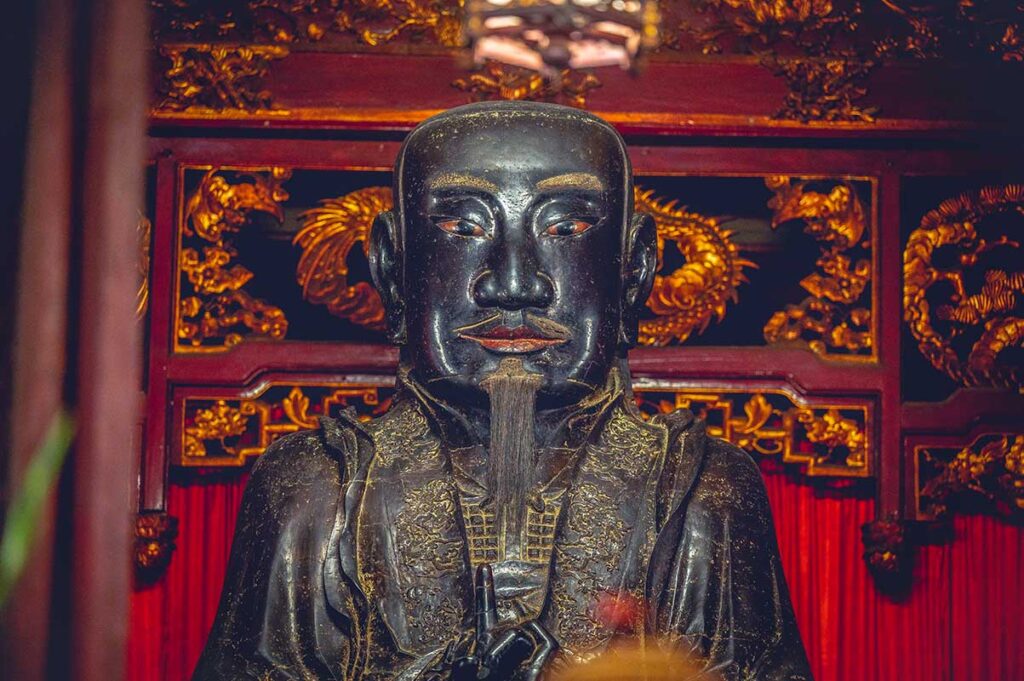
In 1677, the temple received its most iconic feature — a nearly 4-meter-tall bronze statue of Trấn Vũ, along with a large bronze bell. Both were cast by the renowned craftsman Trùm Trọng, whose skill is still celebrated today. Over the centuries, Quan Thanh Temple has undergone multiple renovations, especially during the 17th and 19th centuries, and each major restoration was recorded on engraved stone steles still visible within the temple grounds. Despite its long history, the temple remains an active place of worship and an important symbol of Hanoi’s spiritual heritage.
Highlights of visiting Quan Thanh Temple
1. Triple Gate (Tam Quan)
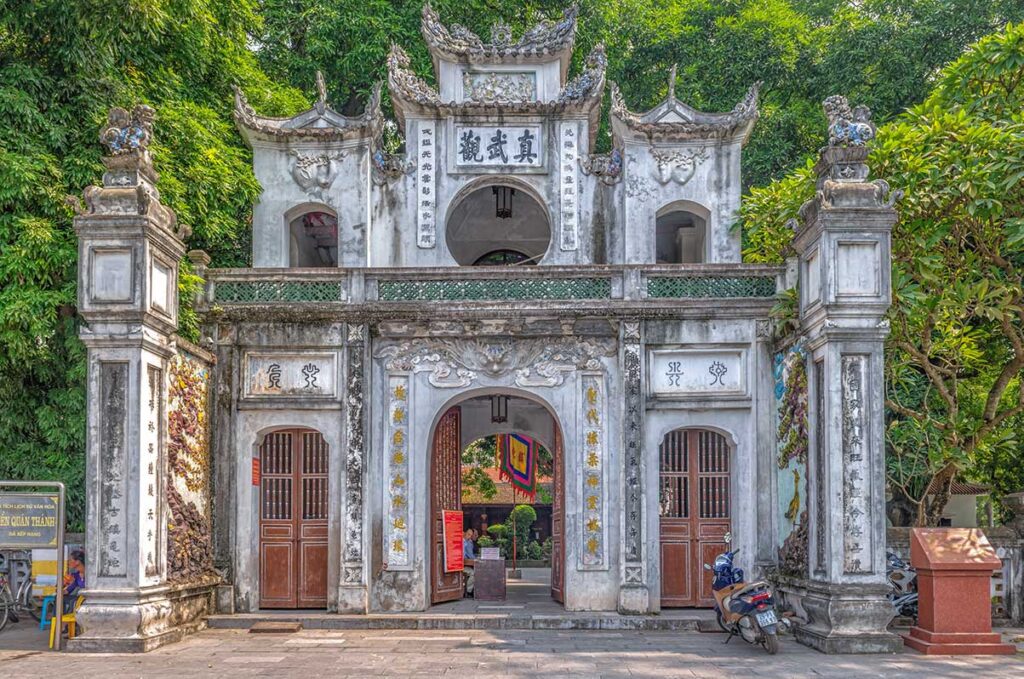
The first thing you’ll see is the grand Tam Quan, or triple gate — a traditional element in Vietnamese religious architecture. This entrance is flanked by four tall pillars topped with sculpted unicorns and decorated with phoenix imagery, both important symbols in Taoism and Vietnamese mythology. The gate serves as a spiritual threshold, separating the outside world from the sacred space within.
2. Courtyard and Banyan Tree
The red couplets mounted on the pillars add a poetic and ceremonial feel, while the curved tiled roofs and detailed carvings reflect the imperial-era style. Though modest in scale compared to large pagodas, the gate sets the tone for the temple’s atmosphere: reverent, historic, and full of symbolism.
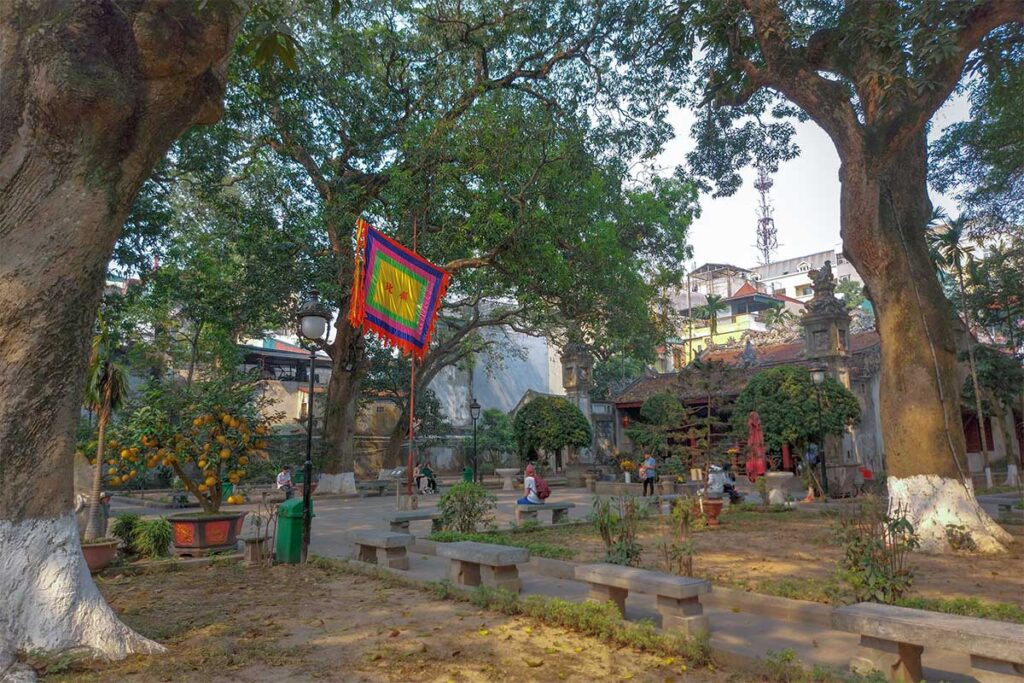
Beyond the gate, you’ll step into a quiet, shaded courtyard dominated by a sprawling banyan tree. This area offers a sense of calm — with birds chirping, smoke rising gently from incense sticks, and the rustle of leaves above. Visitors often pause here before entering the main hall, especially during spiritual holidays when locals come to pray.
In one corner, you’ll find a brick oven used for burning joss paper, especially during Tet and on the 1st and 15th days of the lunar month. Simple stone benches allow for a short rest or quiet contemplation, making the courtyard an unexpectedly tranquil escape from Hanoi’s busy streets.
3. Main Hall & Bronze Statue of Tran Vũ

At the heart of the temple lies its most famous feature: a 3.96-meter-tall black-bronze statue of Trấn Vũ, the Taoist God of the North. Cast in 1677, the statue weighs around 3,600 kilograms and shows the deity in a commanding seated position, flanked by a serpent and a turtle — two powerful symbols in Vietnamese and Taoist belief.
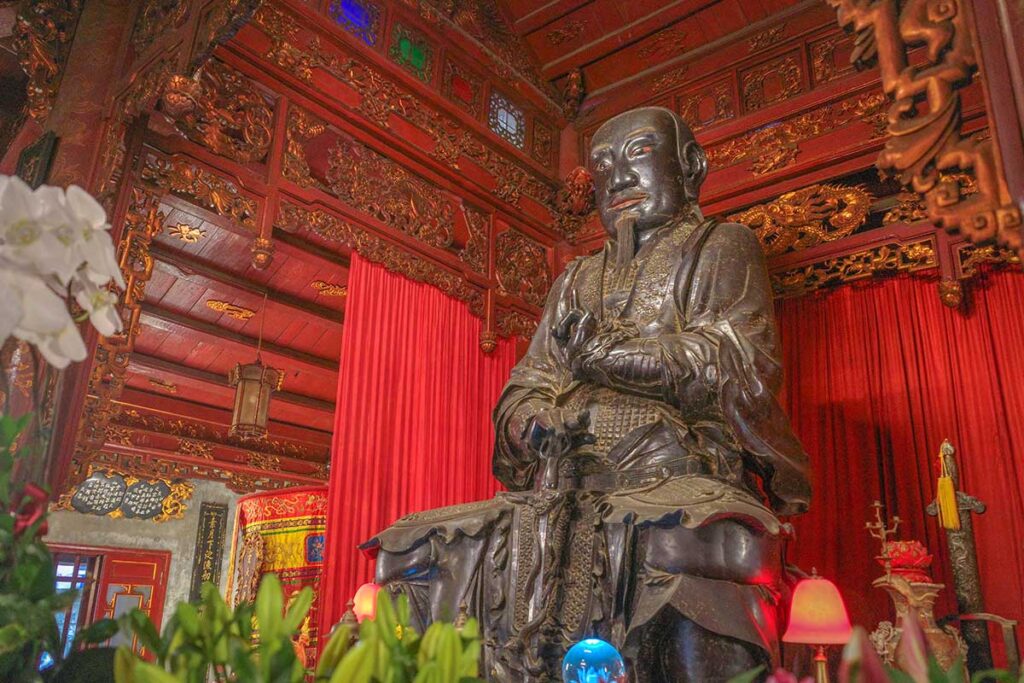
The serpent represents strength and transformation, while the turtle symbolizes protection and stability. Together, they embody the balance of power and peace. The statue is not only a spiritual centerpiece but also a technical achievement, considered one of Vietnam’s most important works of bronze casting. It remains awe-inspiring even centuries after it was created.
4. Bell and the Craftsman Trùm Trong
Beside the statue stands a 1.15-meter bronze bell, cast during the same period by the same artisan: Trùm Trọng, a master craftsman from Ngũ Xã village. What makes this bell especially unique is its pairing with a statue of Trùm Trọng himself, placed in the temple to honor his contribution — a rare recognition for an artisan in religious architecture.
The bell is sometimes used ceremonially and has become part of the temple’s identity, including special events like the “Trấn Vũ Bell Sound” night tour, where its resonance adds to the temple’s mystical ambiance. Together with the main statue, it reflects the artistry and cultural depth of 17th-century Vietnam.
5. Stone Steles and Chinese Texts
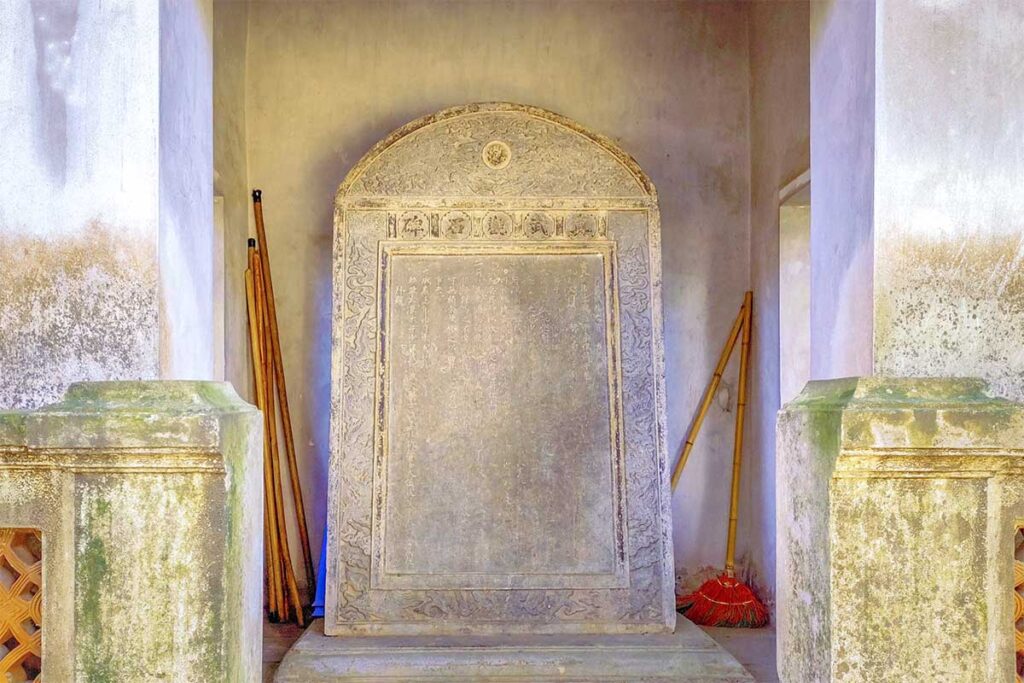
Inside and around the main hall, you’ll find a number of stone steles (inscribed tablets) documenting the temple’s restorations and milestones. The oldest dates to 1677, while the most recent was added in the late 19th century under the French colonial era. These records offer a rare written history of the temple, carved in Literary Chinese, the formal script used in Vietnam before the Latin alphabet was adopted.
While most visitors won’t be able to read the inscriptions, they stand as a powerful reminder of Vietnam’s layered linguistic and cultural past. Many are mounted in a pavilion known as Nhà bia, which also offers some shade and quiet.
6. Worship Rituals and Visiting Days
Quan Thanh Temple is still an active place of worship, especially on the 1st and 15th days of each lunar month, when locals come to offer incense and pray for health, fortune, and protection. It’s also a popular destination during Tết (Lunar New Year) and the Trấn Vũ Festival on the 3rd day of the 3rd lunar month — when rituals, offerings, and performances honor the temple’s guardian deity.
If you visit during one of these times, you’ll get to witness local traditions in action — from families making symbolic offerings to quiet personal prayers beneath the banyan tree. The experience adds spiritual depth to what is otherwise a historical and architectural visit.
How to get there
Part of a walking route
Quan Thanh Temple fits perfectly into a self-guided walking route around West Lake, Truc Bach Lake, and the northern end of Ba Dinh District. It’s just a short walk from Tran Quoc Pagoda and only about 10–15 minutes on foot from landmarks like the Ho Chi Minh Mausoleum and One Pillar Pagoda. If you’re already exploring this part of the city, the temple is an easy and natural stop.
Taxi or Grab
From the Old Quarter or French Quarter, getting to Quan Thanh Temple by taxi or Grab takes about 10 to 15 minutes, depending on traffic. Both GrabCar and GrabBike are widely available and usually cheaper than traditional taxis.
Tip: If you’re not familiar with how Grab works, check out our Grab app guide for help with downloading, booking, and paying.
Nearby sights to combine with
The best way to enjoy Quan Thanh Temple is by including it in a broader visit to this historically rich area of Hanoi. From lakeside walks to national monuments, there’s plenty to see within a short walk or quick ride.
- West Lake – Hanoi’s largest lake offers peaceful walking paths, street food, and lakeside cafés. Great for a relaxed stroll before or after your temple visit.
- Tran Quoc Pagoda – Vietnam’s oldest Buddhist pagoda, beautifully located on a tiny islet in West Lake just across the street. A must-see for its architecture and lakeside setting.
- Truc Bach Lake – Smaller and quieter than West Lake, this area has a local vibe with cafés, walking paths, and even the site where John McCain was captured in 1967.
- Ho Chi Minh Mausoleum – The resting place of Vietnam’s most revered leader, just a 10–15 minute walk away. Closed some days, but worth seeing even from the outside.
- One Pillar Pagoda – A small but iconic temple designed to resemble a lotus flower. Located near the Mausoleum and easily visited on the same route.
- Ho Chi Minh Museum – Just next to the Mausoleum, this museum showcases the life, travels, and revolutionary work of “Uncle Ho” with a mix of history and symbolism.
For more ideas in this area, see our full guide to Ba Dinh Square — a great place to plan a full day of sightseeing.
Pro Tip: Some sights are close, but not right next door. Wear good walking shoes.
Is Quan Thanh Temple worth visiting?
Quan Thanh Temple isn’t the grandest or most visually striking temple in Hanoi — but it stands out for its rare Taoist identity, peaceful setting, and the impressive bronze statue of Trấn Vũ. It offers a quieter, more reflective experience than the city’s larger or busier religious sites.
It’s especially worth visiting if you’re already exploring Tran Quoc Pagoda, West Lake, or the Ba Dinh area. The temple fits naturally into a walking route through this part of Hanoi, making it a meaningful stop rather than a standalone destination.
Curious how it compares with other temples in the city? See our full guide to the Best temples in Hanoi for more ideas.
